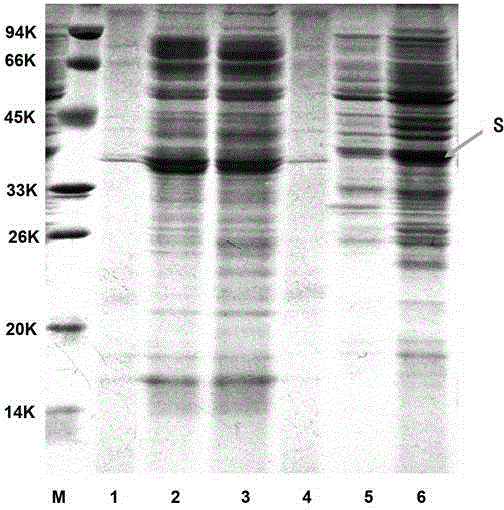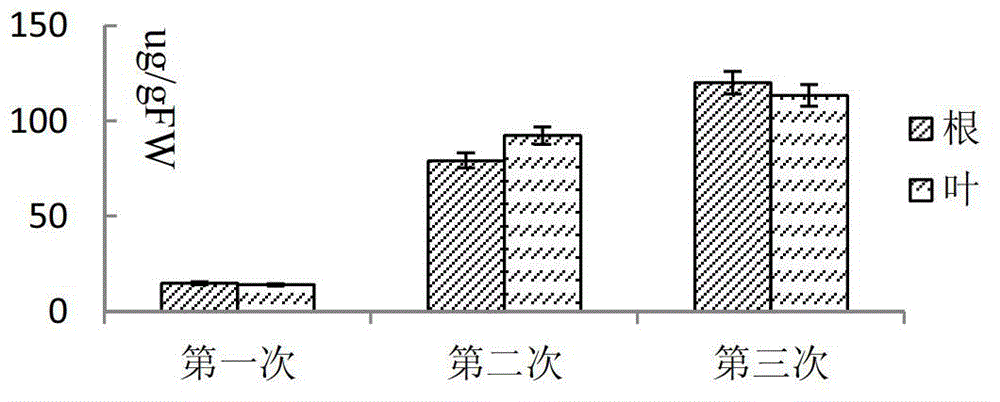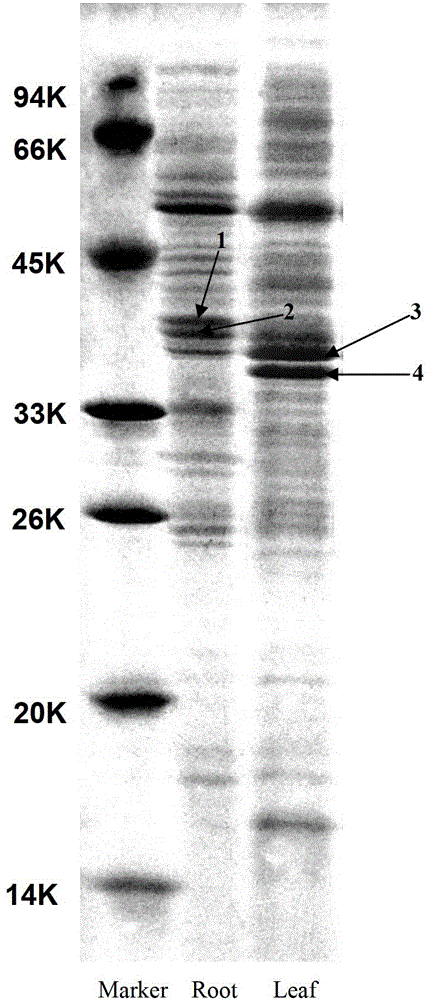Method for extracting apoplast antifreeze proteins from winter rape roots
A technology of antifreeze protein and extraction method, which is applied to the preparation method of peptides, chemical instruments and methods, plant peptides, etc., and can solve the problem that there is no mature method for antifreeze protein in rapeseed
- Summary
- Abstract
- Description
- Claims
- Application Information
AI Technical Summary
Method used
Image
Examples
Embodiment 1
[0033] Example 1: First time sampling, extraction of apoplast protein from the root of No. 6 winter rapeseed Longyou:
[0034] (1) Sampling: On October 5th, Longyou No. 6 roots were dug out in the field, put in an ice box within 3-5 minutes, brought back to the laboratory, and stored in a 4°C refrigerator;
[0035] (2) 1000ml of extraction buffer is prepared according to the following weight and volume:
[0036] 0.05M / L Tris-Hcl6.057g to adjust the pH to 8.0;
[0037] 0.01M / L EDTA-Na2.2H2O (disodium ethylenediaminetetraacetic acid) 3.72g;
[0038] 0.02M / LVC (vitamin c) 3.52g;
[0039] Dilute to 1000ml with ddH2O, and store the prepared buffer at 4°C;
[0040] (3) Cut into strips: remove the soil carried by the root of rapeseed, remove the dead part of the root, rinse with running water for 10-12 minutes, until the sundries are washed, rinse with ddH2O twice, dry the surface moisture with filter paper, wash the root and dissect it Cut into 1-2cm long strips;
[0041] (4) S...
Embodiment 2
[0052] Embodiment 2: sampling for the second time, extraction of apoplast protein from the root of Longyou No. 6:
[0053] (1) Sampling: On November 15th, Longyou No. 6 roots were dug out in the field, put in an ice box within 3-5 minutes, brought back to the laboratory, and stored in a 4°C refrigerator;
[0054] (2) 1000ml of extraction buffer is prepared according to the following weight and volume:
[0055] 0.05M / L Tris-Hcl6.057g to adjust the pH to 8.0;
[0056] 0.01M / L EDTA-Na2.2H2O (disodium ethylenediaminetetraacetic acid) 3.72g;
[0057] 0.02M / LVC (vitamin c) 3.52g;
[0058] Dilute to 1000ml with ddH2O, and store the prepared buffer at 4°C;
[0059] (3) Cut into strips: remove the soil carried by the root of rapeseed, remove the dead part of the root, rinse with running water for 10-12 minutes, until the sundries are washed, rinse with ddH2O twice, dry the surface moisture with filter paper, wash the root and dissect it Cut into 1-2cm long strips;
[0060] (4) Immer...
Embodiment 3
[0071] Example 3: The third sampling, the extraction of the root and leaf apoplast proteins of Longyou No. 6:
[0072] (1) Sampling: On December 1, dig out rapeseed roots in the field, put them in an ice box within 3-5 minutes, bring them back to the laboratory, and store them in a refrigerator at 4°C;
[0073] (2) 1000ml of extraction buffer is prepared according to the following weight and volume:
[0074] 0.05M / L Tris-Hcl6.057g to adjust the pH to 8.0;
[0075] 0.01M / L EDTA-Na2.2H2O (disodium ethylenediaminetetraacetic acid) 3.72g;
[0076] 0.02M / LVC (vitamin c) 3.52g;
[0077] Dilute to 1000ml with ddH2O, and store the prepared buffer at 4°C;
[0078] (3) Cut into strips: remove the soil carried by the root of rapeseed, remove the dead part of the root, rinse with running water for 10-12 minutes, until the sundries are washed, rinse with ddH2O twice, dry the surface moisture with filter paper, wash the root and dissect it Cut into 1-2cm long strips;
[0079] (4) Immer...
PUM
 Login to View More
Login to View More Abstract
Description
Claims
Application Information
 Login to View More
Login to View More - R&D
- Intellectual Property
- Life Sciences
- Materials
- Tech Scout
- Unparalleled Data Quality
- Higher Quality Content
- 60% Fewer Hallucinations
Browse by: Latest US Patents, China's latest patents, Technical Efficacy Thesaurus, Application Domain, Technology Topic, Popular Technical Reports.
© 2025 PatSnap. All rights reserved.Legal|Privacy policy|Modern Slavery Act Transparency Statement|Sitemap|About US| Contact US: help@patsnap.com



